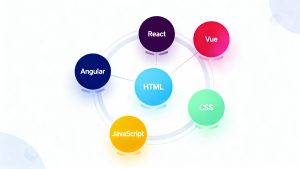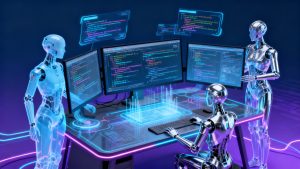In the rapidly evolving world of web development, professionals who can manage both the front-end and back-end of applications are in high demand. Among the most sought-after skill sets is “Full Stack Python,” a term that signifies expertise in using Python and its ecosystem for building complete web solutions. This guide explores what it means to be a Full Stack Python developer, the core technologies involved, and the steps to launch a successful career in this field.
What is Full Stack Python?
Full Stack Python refers to the development of web applications where Python is used on both the server side (back-end) and, in some cases, alongside front-end technologies for a seamless user experience. Unlike traditional web development, which often divides tasks between different specialists, Full Stack Python developers are equipped to handle every stage of the application lifecycle—from designing user interfaces to managing databases and deploying robust server logic.
A Full Stack Python developer is responsible for bridging the gap between client-side and server-side operations, ensuring that web applications are functional, responsive, and secure. Their role is pivotal in startups and established companies alike, as they can deliver end-to-end solutions efficiently.
Key Technologies in Full Stack Python Development
To excel as a Full Stack Python developer, one must master a diverse set of technologies and tools. Below is an overview of the most important components:
Front-End Technologies
- HTML & CSS: The foundation of web design, HTML provides structure, while CSS adds style and visual appeal.
- JavaScript: Essential for creating interactive and dynamic user interfaces.
- Front-End Frameworks: While Python is not typically used on the front end, developers often work with frameworks like React, Vue, or Angular for advanced user experiences.
- User Experience (UX) Design: Understanding UX principles helps in building intuitive and engaging web applications.
Back-End Technologies
- Python Programming: Core competency for writing server-side logic, handling data, and integrating with databases.
- Web Frameworks: Popular Python frameworks such as Django, Flask, and Pyramid streamline the development of robust web applications.
- RESTful APIs: Building APIs enables communication between the front end and back end, facilitating data exchange and integration with other services.
Database Management
- SQL Databases: Familiarity with relational databases like PostgreSQL and MySQL is crucial for data storage and retrieval.
- NoSQL Databases: Experience with databases such as MongoDB is valuable for handling unstructured data.
- ORM Libraries: Tools like SQLAlchemy and Django ORM simplify database interactions within Python applications.
DevOps and Deployment
- Version Control: Using Git for tracking code changes and collaborating with teams.
- Cloud Platforms: Deploying applications on platforms like AWS, Heroku, or Azure ensures scalability and reliability.
- Continuous Integration/Continuous Deployment (CI/CD): Automating testing and deployment processes for efficient software delivery.
The Role and Responsibilities of a Full Stack Python Developer
Full Stack Python developers are versatile professionals who oversee the entire development process. Their responsibilities include:
- Designing and implementing user interfaces that are visually appealing and user-friendly.
- Developing server-side logic using Python frameworks to handle business logic and data processing.
- Managing databases to ensure efficient data storage, retrieval, and security.
- Integrating front-end and back-end components for seamless application functionality.
- Testing and debugging code to identify and fix issues before deployment.
- Deploying applications to production environments and monitoring performance.
- Collaborating with cross-functional teams to deliver high-quality software solutions.
Essential Skills for Full Stack Python Developers
To thrive in this role, developers must cultivate a mix of technical and soft skills:
Technical Skills
- Proficiency in Python: Deep understanding of Python syntax, libraries, and frameworks.
- Front-End Development: Mastery of HTML, CSS, JavaScript, and modern front-end frameworks.
- Back-End Development: Experience with Python web frameworks and RESTful API design.
- Database Management: Knowledge of both SQL and NoSQL databases.
- Version Control: Familiarity with Git and collaborative development workflows.
- DevOps Practices: Understanding of cloud deployment, CI/CD, and server configuration.
Soft Skills
- Problem-Solving: Ability to troubleshoot and resolve technical challenges.
- Communication: Effective collaboration with designers, product managers, and other developers.
- Time Management: Prioritizing tasks and meeting project deadlines.
- Continuous Learning: Staying updated with the latest trends and technologies in web development.
How to Become a Full Stack Python Developer
For those aspiring to enter the field, a structured approach is recommended:
- Learn the Fundamentals: Start with Python programming, including data types, loops, functions, and object-oriented concepts.
- Master Front-End Technologies: Gain proficiency in HTML, CSS, and JavaScript. Explore front-end frameworks like React or Vue for advanced projects.
- Explore Back-End Development: Study Python web frameworks such as Django and Flask. Practice building server-side logic and APIs.
- Understand Databases: Learn to design, query, and optimize both SQL and NoSQL databases.
- Practice Version Control: Use Git to manage code changes and collaborate with others.
- Deploy Applications: Gain experience with cloud platforms and CI/CD pipelines for seamless deployment.
- Build Projects: Apply your skills by developing real-world applications and contributing to open-source projects.
- Pursue Certifications: Consider enrolling in online courses or bootcamps to validate your expertise and enhance your resume.
Career Prospects and Industry Demand
The demand for Full Stack Python developers continues to grow as businesses seek versatile professionals capable of delivering end-to-end solutions. According to industry reports, Python full-stack developers command competitive salaries and enjoy strong job security. The average salary for a Full Stack Python developer in India is approximately Rs. 5.5 LPA, with opportunities for growth in startups, tech companies, and enterprises worldwide.
Conclusion
Full Stack Python development is a dynamic and rewarding career path for those passionate about building modern web applications. By mastering both front-end and back-end technologies, developers can create robust, scalable, and user-friendly solutions that meet the needs of today’s digital landscape. With a commitment to continuous learning and hands-on practice, aspiring developers can position themselves for success in this high-demand field.
Read more such articles from our Newsletter here.



